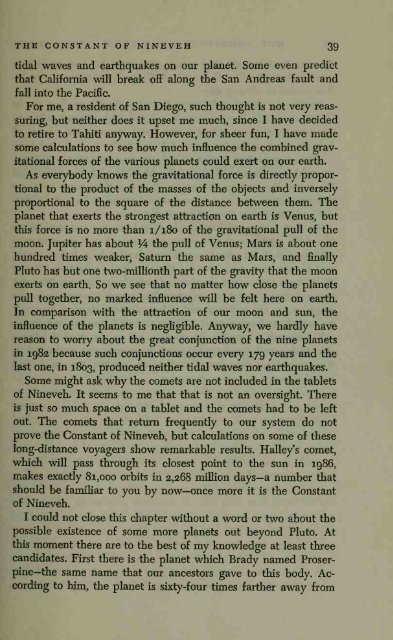Create successful ePaper yourself
Turn your PDF publications into a flip-book with our unique Google optimized e-Paper software.
THE CONSTANT OF NINEVEH 39<br />
tidal waves and earthquakes on our planet. Some even predict<br />
that California will break off along fie San Andreas fault and<br />
fall into the Pacific.<br />
For me, a resident of San Diego, such thought is not very reassuring,<br />
but neither does it upset me much, since I have decided<br />
to retire to Tahiti anyway. However, for sheer fun, I have made<br />
some calculations to see how much influence the combined gravitational<br />
forces of the various planets could exert on our earth.<br />
As everybody knows the gravitational force is directly proportional<br />
to the product of the masses of the objects and inversely<br />
proportional to the square of the distance between them. The<br />
planet that exerts the strongest attraction on earth is Venus, but<br />
this force is no more than 1/180 of the gravitational pull of the<br />
moon. Jupiter has about V4 the pull of Venus; Mars is about one<br />
hundred times weaker, Saturn the same as Mars, and finally<br />
Pluto has but one two-millionth part of the gravity that the moon<br />
exerts on earth. So we see that no matter how close the planets<br />
pull together, no marked influence will be felt here on earth.<br />
In comparison with the attraction of our moon and sun, the<br />
influence of the planets is negligible. Anyway, we hardly have<br />
reason to worry about the great conjunction of the nine planets<br />
in 1982 because such conjunctions occur every 179 years and the<br />
last one, in 1803, produced neither tidal waves nor earthquakes.<br />
Some might ask why the comets are not included in the tablets<br />
of Nineveh. It seems to me that that is not an oversight. There<br />
is<br />
just so much space on a tablet and the comets had to be left<br />
out. The comets that return frequently to our system do not<br />
prove the Constant of Nineveh, but calculations on some of these<br />
long-distance voyagers show remarkable results. Halley's comet,<br />
which v^dll pass through its closest point to the sun in 1986,<br />
makes exactly 81,000 orbits in 2,268 million days—a number that<br />
should be familiar to you by now—once more it is<br />
of Nineveh.<br />
the Constant<br />
I could not close this chapter without a word or two about the<br />
possible existence of some more planets out beyond Pluto. At<br />
this moment there are to the best of my knowledge at least three<br />
candidates. First there is<br />
the planet which Brady named Proserpine—the<br />
same name that our ancestors gave to this body. According<br />
to him, the planet is sixty-four times farther away from

















